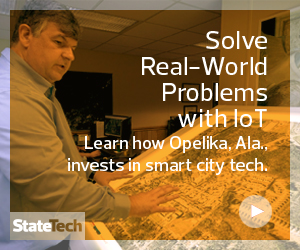1. Infrastructure Must Be a Foundational Element
The basic elements of a smart city today are stitched together from various stakeholders, vendors and technologies, which creates a fragmented ecosystem. As the initiative scales, this environment will not be able to meet its demands, support new technologies or effectively align with planned municipal services or construction efforts.
If you consider the physical infrastructure of a popular city — beautiful parks, well-designed public spaces, residential neighborhoods, museums and a central financial district — its value to citizens is not fully realized without proper roads and public transportation systems. And as that city grows, it will struggle under the load of traffic and not be able to meet the needs of its citizens.
The reality of most cities capable of launching large-scale smart city initiatives is that their physical infrastructure is not suited to support them without significant changes to the existing components, which not only drives up costs but also disrupts the lives of residents.
In this sense, IT infrastructure is equally important — along with a common network delivered through adherence to industry-proven open standards — for a smart city initiative to support the demands of multiple solutions from technology and application providers, systems integrators and infrastructure service providers and operators.
A smart city’s infrastructure platform should enable seamless integration of sensors, applications and services to not only improve returns on capital investments over time, but also provide key stakeholders with a strong foundation for their digital transformation journey.
2. Smart City IT Infrastructure Must Be Agile and Flexible to Scale
Infrastructure that is not scalable will be useless as smart city capabilities continue to evolve. While modular components are indeed necessary building blocks for smart cities, the amount of data used to power these modular components must be able to scale up as the amount of data produced increases.
For instance, as cities continue weaving together bus routes, ride-sharing apps and gridlock patterns with transportation infrastructure like traffic lights, data usage will soar. Without the ability to scale and connect the data pulled from each of these devices, the full benefits of a connected, smart city cannot be fully manifest themselves.
MORE FROM STATETECH: Discover why these smart cities are the ones to watch.
3. Cities Need Effective and Efficient Data Processing and Analytics
The ability to effectively and efficiently capture, store and analyze ever-growing amounts of IoT data closer to the edge is what really accelerates the benefits of smart cities. Smart cities are only as good as their ability to process data, which requires an intelligent and automated infrastructure that can handle exponential data creation and deliver the capabilities required to support long-term storage, processing and analysis.
For example, prioritizing the most important or most useful data is crucial so that it can be processed and analyzed in real time for the continuous delivery of mission-critical business services. Without the ability to automate how data is prioritized, even connectivity will be irrelevant. Smart city initiatives need to invest in infrastructure with intelligence that can scale as needed, handle the data load and support accurate analytics tools in order to react quickly and responsibly.
Facial recognition is a perfect example of an emerging technology that requires infrastructure that can deliver the highest performance across both storage and analytics. It must store large amounts of video footage but also process that footage, looking for specific markers. In the case of school shootings, for example, this can have a profound impact in helping law enforcement identify the shooter and their location in life-saving seconds.
4. Cities Must Protect Residents’ Data to Assuage Privacy Concerns
While infrastructure provides the common foundation and offers advanced capabilities, open data and public trust weighs heavily on the success of a smart city project. In today’s climate, government entities and private companies face rising scrutiny over data collection, with increasing public demand for transparency and oversight.
The burden falls on local officials and city planners to prove that data collection is legal, responsible and, ultimately, in the interest of the public.
To address the issue of trust in the court of public opinion, government entities will likely consider similar measures to the General Data Protection Regulation in Europe, which signals that officials are beginning to listen to privacy concerns and restrict the way organizations control and process personally identifiable information. Initiatives like this could be one key to rebuilding trust, but over time public officials will need to demonstrate a true commitment to driving transparency both for government agencies and private companies, as well as a lasting obligation to protecting the privacy of citizens without compromising public safety.
MORE FROM STATETECH: Explore the back-end infrastructure needed for smart cities.
5. Political Differences Can Be a Roadblock to Smart City Deployments
The intricate dynamics and continuous cycle of politics is another ongoing challenge that could impede smart city initiatives. Large-scale smart city projects are often challenging to fund, as they require buy-in from multiple stakeholders involved in a public-private funding mechanism which blends interests from national, state and local levels with private enterprises.
Smart city projects can also be tied to a city’s political cycles. Political capital can expire before a project is finished, potentially exposing the initiative to scrutiny by an incoming administration, which leads to delays and increased operational complexity. Smart city initiatives require robust strategies that can garner long-term commitments that span administrations, policy and funding schemes. Additionally, smart city project proponents should focus on promoting the forward-thinking nature of these projects and their benefits that span generations with the potential to make business and municipalities more sustainable, improve the quality of life for citizens, drive job creation and spark economic growth.
6. Public and Private Sector Organizations Need to Coordinate
Collaboration and cooperation between key stakeholders in municipalities and the private sector can be another hurdle for smart cities. Government agencies and private sector organizations are often reluctant to share sensitive data or standardize on common networks, tools and infrastructure. This “need-to-know” data-sharing policy can prevent the kind of cross-collaboration that can help cities prevent terrorist attacks, improve drinking water and garbage collection and reduce noise and light pollution.
Buy-in from the police and fire departments, school districts, utilities and service providers can be earned by creating stakeholder groups, offering incentives to encourage open collaboration and highlighting the benefits to each group. One example of this would be building digital infrastructure to support “intelligence-led policing,” which allows law enforcement to monitor data, establish patterns, trends and actionable insights.
For organizations in the private sector, treating the city as a valued customer, getting to know the other players in the smart city market and identifying potential partners are all effective ways to promote a convergence of smart city stakeholders.
The challenges in building smart cities are complex and dynamic. All stakeholders must view it as a long-term infrastructure project while addressing the immediate need for short-term solutions to simplify our increasingly digital, connected and complex world. Maximizing the potential of smart cities will only come through the trust of citizens combined with businesses and governments that prioritize safety, efficiency and sustainability.








.jpg)



